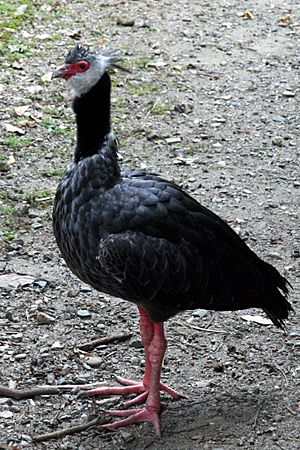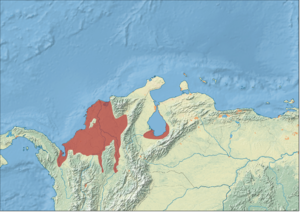Northern screamer facts for kids
Quick facts for kids Northern screamer |
|
|---|---|
 |
|
| Conservation status | |
| Scientific classification | |
| Genus: |
Chauna
|
| Species: |
chavaria
|
 |
|
| Distribution map | |
| Synonyms | |
|
Parra chavaria Linnaeus, 1766 |
|
The northern screamer (Chauna chavaria) is a unique bird found in Colombia and Venezuela. It's part of the waterfowl group, which includes ducks, geese, and swans. This bird is called a "screamer" because of its loud calls! It is currently listed as a Near Threatened species, meaning it could become endangered if its situation doesn't improve.
Contents
About the Northern Screamer
The northern screamer belongs to a small bird family called Anhimidae. It shares its genus, Chauna, with another bird called the southern screamer. There's also a third species in the family, the horned screamer. The northern screamer is considered monotypic, which means it doesn't have any different subspecies.
What Does It Look Like?
Northern screamers are fairly large birds, growing to be about 76 to 91 centimeters (30 to 36 inches) long. They have a strong, sturdy body but a surprisingly small head and a gray beak. Both male and female screamers look alike.
Adult northern screamers have a gray top of the head with a long, feathery crest. Their face is mostly white, and they have a wide black band around their neck. The rest of their body, wings, and tail are dark gray. A cool feature is that their wings have two sharp spurs, almost like little spikes! They also have bare red skin around their brown eyes and reddish-orange legs and feet. Young screamers look similar to adults but their colors are a bit duller.
Where Do They Live?
You can find the northern screamer in northern Colombia, especially around the Atrato River and Magdalena River valleys. Their range extends east into the Lake Maracaibo area of Venezuela. These birds love wet places! They live in swamps, marshes, lagoons, along riverbanks, and in areas that flood during certain seasons.
Northern Screamer Behavior
Movement and Daily Life
Northern screamers generally stay in one place and don't migrate far. However, younger birds or those not currently breeding might wander around locally.
What Do They Eat?
These birds are plant-eaters! They mostly feed on the leaves, stems, and roots of water plants. You might see them grazing, much like geese do, sometimes in loose groups.
Reproduction and Life Cycle
During the breeding season, northern screamers become very protective of their territory. A pair will build a large nest out of plant material and other bits of debris, forming a mound. They can breed at any time of the year, but most eggs are laid in October and November.
A female northern screamer usually lays three to five eggs, but sometimes up to seven. Both parents take turns sitting on the eggs to keep them warm, a process called incubation, which lasts about 42 to 44 days. After the chicks hatch, both parents continue to care for them. The young birds learn to fly (fledge) when they are about eight to ten weeks old and become independent around 12 weeks.
Their Calls
Northern screamers are known for being very noisy birds, just like other members of their family. Their main call is a loud, high-pitched "yelping" sound, often described as "kleer-a-ruk, cherio."
Conservation Status
The IUCN (International Union for Conservation of Nature) first listed the northern screamer as Threatened. Since 2004, it has been listed as Near Threatened, but it's still very close to being considered Threatened again.
There are only an estimated 1,500 to 7,000 adult northern screamers left, and their numbers are decreasing. They face several challenges:
- Habitat Loss: Their wet habitats are being destroyed by pollution from homes and industries, and by cities expanding.
- Human Activities: People sometimes collect their eggs or hunt them for food.
Even though they live in some protected areas in Colombia, these places are also affected by habitat destruction. Protecting their homes is very important to help these unique birds survive!
See also
 In Spanish: Chicagüire para niños
In Spanish: Chicagüire para niños


